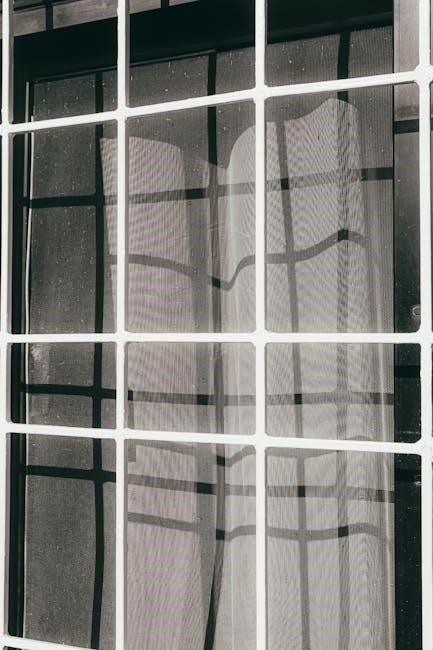Proper bike frame size is crucial for comfort, performance, and injury prevention. This guide helps riders choose the right Specialized bike based on height, inseam, and body proportions.
1.1 Understanding the Importance of Proper Frame Size

Proper frame size is essential for optimal comfort, performance, and safety while cycling. A well-fitted bike ensures efficient power transfer, better control, and reduced risk of injury. Incorrect sizing can lead to discomfort, fatigue, and long-term physical strain. Standing over the bike with adequate clearance (2 cm gap) is critical for safety and comfort. Specialized bikes are designed with precise geometry to match rider proportions, making frame size selection vital for maximizing the cycling experience. Understanding the importance of proper fit helps riders enjoy their bike to the fullest while preventing potential health issues.
1.2 Overview of Specialized Bike Models and Their Frame Sizes
Specialized offers a wide range of bike models, each designed with specific frame sizes to cater to diverse rider needs. Road bikes like the Tarmac SL7, Roubaix, and Allez feature size charts ranging from 44cm to 64cm, ensuring precise fit for varying rider heights. Mountain bikes, such as the Stumpjumper and Epic, also offer size options tailored to rider proportions. Hybrid and active bikes, including the Sirrus and Turbo Vado, provide versatile sizing for comfort and utility. Each model’s frame size chart is carefully designed to match rider height and preferences, ensuring optimal performance and comfort across all cycling disciplines.

How to Measure Your Body for a Specialized Bike
Accurate body measurements are essential for proper bike fit. Start with height and inseam, then consider other proportions to ensure optimal performance and comfort.
2.1 Measuring Your Height Accurately
To measure your height accurately, stand barefoot on a flat surface, feet shoulder-width apart, and back against a wall. Ensure your head is level, shoulders relaxed, and heels touching the wall. Use a pencil to mark the wall at the top of your head. Measure this mark with a tape measure to get your height in inches or centimeters. This measurement is crucial for determining the appropriate bike frame size using Specialized’s size charts.
2.2 Calculating Your Inseam for Standover Clearance
To calculate your inseam for standover clearance, stand barefoot and measure the distance from the floor to the top of your inner thigh using a flexible tape measure or string. Ensure the tape is level and not too tight. This measurement helps determine the appropriate frame size using Specialized’s size charts. Aim for about 2 centimeters of clearance between the frame and your groin when standing over the bike. Combine this with your height for accurate sizing, as inseam can vary among individuals of the same height. This ensures comfort, safety, and optimal performance.
2.3 Considering Other Body Measurements for Optimal Fit
Beyond height and inseam, other body measurements play a role in achieving the best bike fit. Arm length, torso length, and leg proportions should be considered to ensure proper reach and comfort. For example, riders with longer arms may benefit from a slightly longer stem or handlebars, while those with shorter torsos might prefer a more compact frame. These measurements help fine-tune the fit, ensuring optimal ergonomics and riding comfort. Specialized’s sizing charts often account for these factors, but personal adjustments may still be needed for the perfect setup.

Specialized Road Bike Frame Size Guide
This guide provides detailed size charts and fit recommendations for Specialized road bikes, including popular models like Tarmac, Roubaix, and Allez. It helps riders choose the optimal frame size based on height, inseam, and body proportions, ensuring comfort and performance.
3.1 Specialized Tarmac SL7 Size Chart
The Specialized Tarmac SL7 offers a range of frame sizes to fit various rider heights. The size chart recommends frame sizes from 49cm to 61cm, corresponding to rider heights from 5’1″ to 6’5″. For example, a rider measuring 5’10”-6’0″ typically fits a 56cm frame; The Tarmac SL7 is known to run true-to-size but may feel slightly small for some riders, so those between sizes should consider sizing up. Proper fit ensures optimal performance, comfort, and efficiency. Always refer to the official Specialized geometry chart and consider a test ride to confirm the best fit for your body proportions.
3;2 Specialized Roubaix Size Chart
The Specialized Roubaix size chart offers a wide range of frame sizes, from 44cm to 64cm, catering to riders of various heights and preferences. The 2021 model, for instance, provides sizes up to 61cm for taller riders. When choosing a size, consider both height and riding style, as the Roubaix’s endurance-focused geometry may require a slightly different fit compared to road bikes like the Tarmac. Riders between sizes are advised to test ride or opt for the larger frame for comfort. The chart aligns rider height with frame size, ensuring optimal comfort and performance for endurance riding.
3.3 Specialized Allez Size Chart
The Specialized Allez size chart provides a detailed guide to help riders select the perfect frame size. Sizes range from 49cm to 61cm, catering to a wide range of rider heights. For example, a 49cm frame is ideal for riders measuring 155-163cm, while a 61cm frame suits taller riders up to 196cm. The chart aligns height with frame size, ensuring proper fit and comfort. Key measurements include height, inseam, and standover clearance, with a recommended 2cm gap between the tire and the floor. This ensures optimal performance and comfort for the Allez, a versatile aluminum road bike designed for both entry-level and experienced riders.
3.4 Factors Affecting Road Bike Frame Fit
Beyond frame size, several factors influence road bike fit. Geometry plays a significant role, as elements like wheelbase, head tube angle, and seat tube angle affect handling and comfort. Rider height and inseam are critical for standover clearance, ensuring safety and comfort. Body proportions, such as torso and arm length, impact reach and handlebar position. Weight distribution also matters, affecting balance and control. These factors, combined with frame size, ensure a tailored fit for optimal performance and comfort on the road.

Specialized Mountain Bike Frame Size Guide
Specialized mountain bikes offer precise fit through size-specific geometry. Models like Stumpjumper and Epic provide tailored sizing for various rider heights, ensuring optimal comfort and performance on trails.
4.1 Specialized Stumpjumper and Stumpjumper Evo Size Chart
The Stumpjumper and Stumpjumper Evo size charts are designed to ensure a perfect fit for mountain bikers. Sizes range from S1 (41-53 cm, 150-160 cm height) to S6 (62-65 cm, 188-196 cm height). The Evo model offers slightly adjusted geometry for enhanced performance. Standover clearance is crucial, with a recommended 2 cm gap between the tire and the floor when standing over the bike. Proper sizing ensures optimal handling, comfort, and efficiency on trails. Refer to the official Specialized size guide for precise measurements and to match your height with the correct frame size.
4.2 Specialized Epic and Epic Hardtail Size Chart
The Specialized Epic and Epic Hardtail bikes cater to cross-country riders, offering tailored sizing for optimal performance. The size chart ranges from S1 (41-53 cm, 150-160 cm height) to S6 (62-65 cm, 188-196 cm height). The Epic features a lightweight frame with precise handling, while the Hardtail offers a more straightforward design. Both models emphasize proper fit for efficiency and comfort. Riders should consider their height, inseam, and riding style when selecting a size. Refer to the official Specialized geometry chart for detailed measurements, ensuring the best match for your body proportions and riding preferences.
4.3 Specialized Rockhopper Size Chart
The Specialized Rockhopper is a versatile hardtail mountain bike designed for durability and performance. Its size chart ranges from S1 (41-53 cm, 150-160 cm height) to S6 (62-65 cm, 188-196 cm height). Each size ensures optimal fit for riders of varying heights and inseam measurements. The Rockhopper’s geometry is tailored for cross-country riding, with a focus on comfort and control. Riders between sizes may prefer sizing up for a more comfortable standover clearance. Refer to the official Specialized geometry chart for precise frame measurements, ensuring the best fit for your riding style and body proportions.
4.4 Mountain Bike Geometry and How It Affects Fit
Mountain bike geometry plays a critical role in fit and riding performance. Key measurements like wheelbase, head tube angle, and seat tube angle influence handling and comfort. A shorter wheelbase improves maneuverability, while a slack head tube angle enhances stability at speed. Seat tube angle affects pedaling efficiency and saddle position. Standover clearance, determined by inseam, ensures safe dismounting. Proper geometry alignment with rider proportions maximizes control and reduces fatigue. Consulting Specialized’s geometry charts and test riding bikes helps tailor fit to individual needs, ensuring optimal performance and comfort on trails.

Specialized Hybrid and Active Bike Frame Size Guide
Specialized hybrid and active bikes offer versatile sizing for comfort and efficiency. Models like Sirrus and Turbo Vado feature size charts based on height and inseam measurements, ensuring optimal fit for various riding styles and preferences.
5.1 Specialized Sirrus Size Chart
The Specialized Sirrus size chart is designed to provide a comfortable and efficient ride for hybrid bike enthusiasts. Sizes range from 49cm to 64cm, catering to a wide range of rider heights. For example, a rider measuring 5’1″-5’3″ (155-160 cm) typically fits a 52cm frame, while taller riders up to 6’4″ (193 cm) can opt for a 64cm frame. The chart emphasizes standover clearance and saddle height adjustments to ensure proper fit. Hybrid bikes like the Sirrus are versatile, making them ideal for commuting, fitness, or casual rides, with sizing tailored to maximize comfort and performance across various terrains.
5.2 Specialized Turbo Vado Size Chart
The Specialized Turbo Vado size chart offers a range of frame sizes to suit various rider heights, ensuring optimal comfort and performance. Sizes typically range from 49cm to 64cm, catering to riders from 5’1″ (155 cm) to 6’4″ (193 cm). The chart provides recommended frame sizes based on height, with adjustments for standover clearance and saddle height. The Turbo Vado, a hybrid e-bike, combines efficiency and comfort, making it ideal for commuting or fitness rides. Proper sizing ensures riders can fully benefit from its electric assist and ergonomic design, delivering a seamless and enjoyable cycling experience across diverse terrain and conditions.
5.3 Factors to Consider for Hybrid Bike Fit
When selecting a hybrid bike, consider factors like height, inseam, and standover clearance to ensure proper fit. Measure your height accurately and compare it to the size chart. Standover clearance should allow a 2cm gap for comfort and safety. Additionally, consider handlebar height, saddle comfort, and reach to maintain an ergonomic riding position. Your riding style and terrain preferences also play a role, as hybrid bikes are versatile for both on-road and light off-road use. Test rides are highly recommended to confirm the best fit for your needs and preferences.

Specialized Kids Bike Frame Size Guide
Specialized kids bikes are sized by wheel size and rider height, ensuring proper fit and safety. Models like the Sirrus offer options for growing riders, with frames designed to accommodate different age ranges and riding styles.
6.1 Size Chart for Specialized Kids Bikes
Specialized kids bikes are designed with growth and safety in mind. The size chart is based on wheel size and rider height, ensuring proper fit. Models like the Sirrus and Hotwalk cater to children of various ages and skill levels. For example, the Hotwalk is ideal for young riders just starting, while the Jett is designed for older kids. The chart typically ranges from 12-inch to 24-inch wheels, corresponding to rider heights from 35 inches to 59 inches. This ensures a safe and comfortable ride, promoting confidence and skill development for young cyclists.
| Model | Wheel Size | Rider Height |
|---|---|---|
| Hotwalk | 12″ | 35-43″ |
| Jett | 20″ | 45-53″ |
| Sirrus | 24″ | 55-59″ |
6;2 How to Choose the Right Bike for Your Child
Choosing the right bike for your child involves considering their age, skill level, and growth. Start with a bike that fits their height and inseam to ensure proper standover clearance for safety. Test different wheel sizes to match their riding ability, whether they’re just learning or already confident. Adjustable saddles and handlebars can accommodate growth. Lighter bikes are easier for kids to handle. Additionally, look for features like child-friendly brakes and durable frames. Allow your child to test ride bikes to ensure comfort and confidence. This approach ensures they enjoy cycling while staying safe and supported.

Using Specialized Geometry Charts for Precise Fit
Specialized geometry charts provide detailed frame measurements, ensuring precise fit by matching rider proportions with optimal bike dimensions for comfort, performance, and easy adjustments.
7.1 What Is a Geometry Chart and How to Read It
A geometry chart is a detailed table listing a bike’s frame measurements across various sizes. It includes data like seat tube length, head tube angle, wheelbase, and chainstay length. To read it, start by identifying your bike model and desired size. Match your height and inseam to the chart to find the ideal frame size. Pay attention to key measurements that affect fit, such as standover clearance and reach. This chart ensures your bike proportions align with your body for optimal comfort and performance. Understanding it helps you make informed decisions and adjustments for the perfect fit.
7.2 How Geometry Charts Relate to Frame Size
Geometry charts provide detailed measurements for each frame size, ensuring proper fit and performance. They list dimensions like seat tube length, head tube angle, and wheelbase, scaling proportionally with frame size. By aligning these measurements with your body proportions, the charts help determine the ideal frame size. For example, taller riders may need longer frames with adjusted geometry for comfort. This relationship ensures the bike handles optimally and fits comfortably, whether for road, mountain, or hybrid models. Using geometry charts alongside size guides guarantees a precise match for your riding style and body dimensions.

Test Rides and Adjustments
Test rides are essential to confirm frame size and fit. Adjust stem length and components for comfort and performance, ensuring optimal ergonomics and riding experience.
8.1 The Importance of Test Riding Different Sizes
Test riding different sizes ensures the best fit and comfort. While size charts provide a starting point, physical interaction with the bike reveals how it handles and feels. Standing over the bike, check for proper standover clearance, typically 2-4 cm for road bikes and more for mountain bikes. A test ride allows you to assess reach, saddle comfort, and handling. If between sizes, test riding helps determine whether to size up or down. This step ensures optimal ergonomics and performance, making the riding experience enjoyable and efficient.
8.2 Adjusting Stem Length and Other Components for Optimal Fit
Adjusting stem length and other components fine-tunes your bike fit for comfort and performance. A shorter stem reduces reach, while a longer stem increases it, impacting handling and comfort. Handlebar width should match shoulder width for optimal ergonomics. Saddle height and fore-aft position also play a crucial role; ensure proper leg extension and avoid excessive reach. For models like the Tarmac SL7, small adjustments can significantly improve fit. Consider professional fitting or test rides to dial in your setup, ensuring every component aligns with your body for a tailored riding experience that enhances efficiency and reduces discomfort.

Troubleshooting Common Fit Issues
Common fit issues include discomfort, poor posture, or limited mobility. Address these by adjusting components like saddles or stems and ensuring proper frame size alignment.
9.1 What to Do If You’re Between Sizes
If you find yourself between two frame sizes, consider factors like riding style and terrain. For Specialized models like the Epic, sizing up may provide better comfort and control. Test rides are crucial to determine the best fit, as personal comfort can vary. Adjustments such as stem length and saddle height can further refine the fit. Ensure proper standover clearance and consult a professional fitter if needed. Prioritize how the bike feels during your ride, as this will greatly impact your overall cycling experience and performance.
9.2 Resolving Discomfort Through Frame Size Adjustments
Discomfort often arises from improper frame size or fit. If your bike feels too small, consider a larger size for better reach and standover clearance. For a bike that feels too large, a smaller frame may improve control. Adjustments like stem length, handlebar width, and saddle height can also alleviate discomfort. Test rides are essential to gauge comfort and performance. Refer to Specialized’s geometry charts to ensure proper fit. If issues persist, consult a professional bike fitter to fine-tune your setup and optimize your riding experience.
Choosing the right Specialized frame size ensures optimal comfort, performance, and riding enjoyment. Use size charts, test rides, and expert advice to make an informed decision.
10.1 Final Tips for Choosing the Right Specialized Frame Size
When selecting your Specialized bike, prioritize comfort and performance by accurately measuring your height and inseam. Refer to the official size charts for precise frame recommendations. Always test ride different sizes to ensure the best fit, as sizing can vary slightly between models. Consider future adjustments, such as stem length, to optimize your riding position. If unsure, consult with a professional fitter or local bike shop for personalized advice. Remember, the right frame size enhances your cycling experience, so take the time to get it just right for years of enjoyable rides.
10.2 Where to Find Additional Resources and Support
For further assistance, visit the official Specialized website, which offers detailed geometry charts, size guides, and model-specific information. Local bike shops are also excellent resources, providing personalized advice and test rides. Additionally, downloadable PDF guides and sizing manuals are available on the Specialized archive section. For technical inquiries, contact Specialized customer support directly. Ensure a perfect fit by utilizing tools like Retül fit data and consulting professional fitters. These resources help you make informed decisions and enjoy a seamless cycling experience with your Specialized bike.

